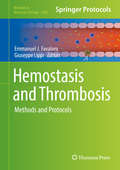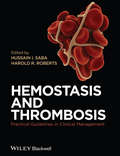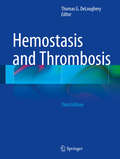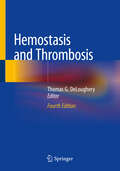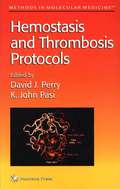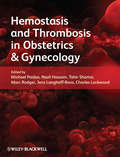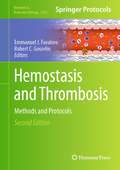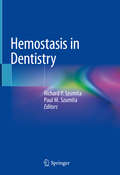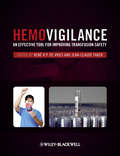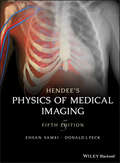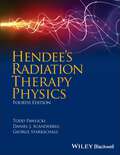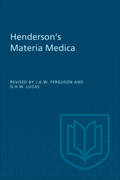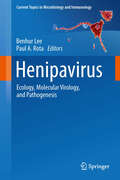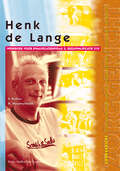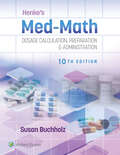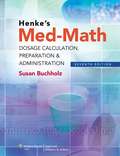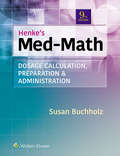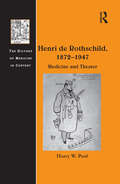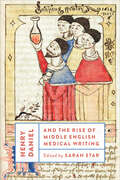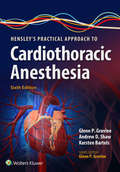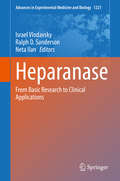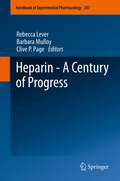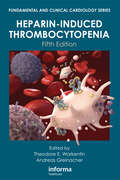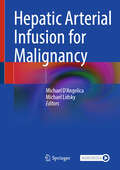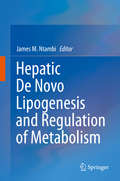- Table View
- List View
Hemostasis and Thrombosis
by Emmanuel J. Favaloro Giuseppe LippiThis collection thoroughly explores the dynamic and ever-developing field of hemostasis and thrombosis diagnostics and research. After an introductory section covering the basics and preanalytical issues, the book continues with in-depth sections that explore how to get the best outcomes from routine coagulation and specialized hemostasis assays, thrombophilia-related techniques, investigations into bleeding disorders, as well as performance of global assays of hemostasis, and finally post-analytical issues in hemostasis and thrombosis testing. Written in the highly successful Methods in Molecular Biology series format, chapters include introductions to their respective topics, lists of the necessary materials and reagents, step-by-step, readily reproducible laboratory protocols, and tips on troubleshooting and avoiding known pitfalls. Comprehensive and practical, Hemostasis and Thrombosis: Methods and Protocols serves as an ideal resource for researchers and diagnostic laboratories seeking expert guidance and working to identify the best methodologies to pursue hemostasis and thrombosis testing.
Hemostasis and Thrombosis
by Hussain I. Saba Harold R. RobertsThrombotic and bleeding disorders affect at least 10 million people in the US alone. As a result there has been much more interest and research into this field. The field of haematology is undergoing major advances in thrombosis research, including significant additions to recommended treatment protocols and guidelines. This new handbook will cover all aspects of the practical mangement of commonly encountered thrombotic and bleeding disorders, with emphasis on clinical diagnosis, treatment and day-to-day management. It will distil the most clinically relevant material from the literature for all those working in the field of haemostasis and thrombosis.
Hemostasis and Thrombosis
by Thomas G. DelougherySince the second edition of Hemostasis and Thrombosis published over a decade ago, advances on assessing, treating and preventing common and rare hemostatic problems have emerged. This latest edition features these new developments while providing practical information on diagnosing and managing these troublesome conditions often found in clinical practice. Concise and convenient, healthcare professionals will find this text to be an invaluable resource.
Hemostasis and Thrombosis (Vademecum Ser.)
by Thomas G. DeLougheryThe latest edition of this practical handbook provides a concise yet comprehensive overview of common and rare problems with hemostasis and thrombosis. Through thoroughly updated and revised chapters, the text features practical information on diagnosing and managing troublesome hematologic conditions often found in clinical practice. The handbook also spotlights advances in the field since the publication of the last edition, including multiple novel coagulation factors for hemophilia, the increasing use of novel anticoagulants and their reversal agents, and the increasing use of genetics for diagnosis. Written by experts in the field, Hemostasis and Thrombosis, Fourth Edition is an invaluable resource for healthcare professionals who treat patients afflicted with these conditions.
Hemostasis and Thrombosis Protocols
by David J. Perry K. John PasiLeading experimentalists describe in detail their proven, cutting-edge methods for research on hemostasis and thrombosis, as well as their diagnostics. The techniques range from widely used basic assays to methods that are specialized for mutational analysis and specific disorders. Readily reproducible, these powerful methods can be used to screen for such inherited disorders as hemophilia A and B, von Willebrand's Disease, factor XI and antithrombin deficiency, protein S deficiency, factor V Leiden mutation, and other problems. Hemostasis and Thrombosis Protocols reflects the many major advances that have occurred in our understanding of the molecular genetics of normal hemostasis and its variants. It enables experienced and novice investigators readily to master the complexities of research on molecular hemostasis and thrombosis, as well as work toward the development of new molecular diagnostics.
Hemostasis and Thrombosis in Obstetrics and Gynecology
by Charles J. Lockwood Tahir S. Shamsi M. Enamul Hossain Michael J. Paidas Jens Langhoff-Roos Marc A. RodgerReproductive hemostasis: A global approach to a global challengeA hemostatic change in women through their reproductive lifetime is emerging as an issue of global importance. No wonder, as obstetric hemorrhage remains a major cause of maternal mortality in both developed and developing countries. Thrombophilias and pulmonary embolisms are a threat to maternal and fetal well-being.Hemostasis and Thrombosis in Obstetrics & Gynecology provides a framework for assessing and managing hemostatic disorders in women. Written by an international team, it provides globally applicable guidelines for obstetric hematology. The practical approach to clinical management includes:Hematologic changes in pregnancyRed cell disordersPlatelet disordersInherited and acquired thrombophiliaInherited bleeding disordersPostpartum hemorrhageBlood and bleeding disorders in women can be managed by obstetrician-gynecologists or hematologists, separately or together. Hemostasis and Thrombosis in Obstetrics & Gynecology provides specialists from both disciplines with the information necessary to manage their patients effectively.
Hemostasis and Thrombosis: Methods and Protocols (Methods in Molecular Biology #2663)
by Emmanuel J. Favaloro Robert C. GosselinThis second edition volume expands on the previous edition with updates about the latest state-of-the-art techniques used in leading hemostasis and thrombosis laboratories for diagnosis and exclusion of hemorrhagic and thrombotic diseases. The chapters in this book are organized into seven parts. Part One provides a general overview on hemostasis and thrombosis, preanalytical issues in testing, and routine hemostasis assays. Part Two covers laboratory testing for thrombophilia, including reviews for activated protein C resistance, protein C, lupus anticoagulant testing, and antiphospholipid antibodies. Part Three addresses monitoring continuous anticoagulant infusions and measuring the effects of oral anti-thrombotic therapy. Part Four talks about heparin induced thrombocytopenia and vaccine induced immune thrombotic thrombocytopenia. Part Five and Six cover ADAMTS13 activity testing and new information on bleeding disorders such as chromogenic factor VIII assays, measurement of emicizumab, and treatment of hemophilia A and B. Finally, Part Seven discusses global assays, research applications, and postanalytical considerations. Written in the highly successful Methods in Molecular Biology series format, chapters include introductions to their respective topics, lists of the necessary materials and reagents, step-by-step, readily reproducible laboratory protocols, and tips on troubleshooting and avoiding known pitfalls.Cutting-edge and comprehensive, Hemostasis and Thrombosis: Methods and Protocols, Second Edition is a valuable resource for scientists and researchers struggling to identify the appropriate methods for hemostasis and thrombosis testing, or who seek additional expert guidance on such testing.
Hemostasis in Dentistry
by Richard P. Szumita Paul M. SzumitaThis book offers a thorough, clinically oriented review of hemostasis and its impact on the practice of dentistry. Readers will gain a sound understanding of the pathophysiology of hemostasis and the pharmacology of antithrombotic and prothrombotic medications. Perioperative dental management strategies of value in patients with different congenital and acquired disorders of hemostasis are carefully explained, and the role of surgical techniques and local and topical agents in helping to minimize and control bleeding is described. Helpful instruction is also provided on the indications for antithrombotic medications and the management of patients receiving such therapy, including the risks of altering medications. As the number of available oral antithrombotic agents continues to increase, dentists will encounter significantly more patients receiving treatments that affect hemostasis. In presenting comprehensive, up-to-date information on hemostasis, hemostatic disorders, antithrombotic therapy, and safe dental management, this book will serve as a rich source of information and a useful guide for practitioners and students alike.
Hemovigilance
by René R. De Vries Jean-Claude Faber* Hemovigilance is a "quality process" which aims to improve quality and increase safety of blood transfusion, by surveying all activities of the blood transfusion chain, from donors to recipients.Hemovigilance programmes have now been in existence for over 15 years, but many countries and centers are still at the development stage. This valuable resource brings together the main elements of such programmes and shows the different types of models available. A general introduction includes Chapters on hemovigilance as a quality tool for transfusion as well as concepts of and models for hemovigilance. The core of the book describes how Hemovigilance systems have been set up and how they work in hospitals, blood establishments, and at a national level. These Chapters are written according to a structured template: products and processes, documentation of jobs, monitoring and assessment, implementation and evaluation of measures for improvement, education and training. Chapters on Hemovigilance at the International level, Achievements and new developments complete the picture.Hemovigilance is above all a practical guide to setting up and improving hemovigilance systems, whilst raising awareness for reporting adverse events and reactions.This is the first international book on hemovigilance, assembling all the vital issues in one definitive reference source - essential reading for all staff involved in the transfusion process.
Hendee's Physics of Medical Imaging
by Ehsan Samei Donald J. PeckAn up-to-date edition of the authoritative text on the physics of medical imaging, written in an accessible format <P><P> The extensively revised fifth edition of Hendee's Medical Imaging Physics, offers a guide to the principles, technologies, and procedures of medical imaging. Comprehensive in scope, the text contains coverage of all aspects of image formation in modern medical imaging modalities including radiography, fluoroscopy, computed tomography, nuclear imaging, magnetic resonance imaging, and ultrasound. <P><P> Since the publication of the fourth edition, there have been major advances in the techniques and instrumentation used in the ever-changing field of medical imaging. The fifth edition offers a comprehensive reflection of these advances including digital projection imaging techniques, nuclear imaging technologies, new CT and MR imaging methods, and ultrasound applications. The new edition also takes a radical strategy in organization of the content, offering the fundamentals common to most imaging methods in Part I of the book, and application of those fundamentals in specific imaging modalities in Part II. These fundamentals also include notable updates and new content including radiobiology, anatomy and physiology relevant to medical imaging, imaging science, image processing, image display, and information technologies. <P><P> The book makes an attempt to make complex content in accessible format with limited mathematical formulation. The book is aimed to be accessible by most professionals with lay readers interested in the subject. The book is also designed to be of utility for imaging physicians and residents, medical physics students, and medical physicists and radiologic technologists perpetrating for certification examinations. The revised fifth edition of Hendee's Medical Imaging Physics continues to offer the essential information and insights needed to understand the principles, the technologies, and procedures used in medical imaging.
Hendee's Radiation Therapy Physics
by George Starkschall Daniel J. Scanderbeg Todd PawlickiThe publication of this fourth edition, more than ten years on from the publication of Radiation Therapy Physics third edition, provides a comprehensive and valuable update to the educational offerings in this field. Led by a new team of highly esteemed authors, building on Dr Hendee's tradition, Hendee's Radiation Therapy Physics offers a succinctly written, fully modernised update. Radiation physics has undergone many changes in the past ten years: intensity-modulated radiation therapy (IMRT) has become a routine method of radiation treatment delivery, digital imaging has replaced film-screen imaging for localization and verification, image-guided radiation therapy (IGRT) is frequently used, in many centers proton therapy has become a viable mode of radiation therapy, new approaches have been introduced to radiation therapy quality assurance and safety that focus more on process analysis rather than specific performance testing, and the explosion in patient-and machine-related data has necessitated an increased awareness of the role of informatics in radiation therapy. As such, this edition reflects the huge advances made over the last ten years. This book: Provides state of the art content throughout Contains four brand new chapters; image-guided therapy, proton radiation therapy, radiation therapy informatics, and quality and safety improvement Fully revised and expanded imaging chapter discusses the increased role of digital imaging and computed tomography (CT) simulation The chapter on quality and safety contains content in support of new residency training requirements Includes problem and answer sets for self-test This edition is essential reading for radiation oncologists in training, students of medical physics, medical dosimetry, and anyone interested in radiation therapy physics, quality, and safety.
Henderson's Materia Medica
by George Lucas James FergusonNow in its third edition, this standard text meets the need for a single source of detailed information on the drugs in use in English-speaking countries. Dr. Henderson based his book on the British Pharmacopoeia, and the revisers have included the preparations in the fourteenth revision of the United States Pharmacopoeia, pointing out differences and similarities in terminology and usage. Drugs are arranged by English rather than Latin titles.
Henipavirus
by Benhur Lee Paul A. RotaHenipaviruses form a new genus of emerging paramyxoviruses that are the deadliest human pathogens within the Paramyxoviridae family. This volume deals with the many facets of henipavirus biology, and covers our current understanding regarding the ecology, molecular virology, and pathogenesis of henipavirus infections. It is an international effort written by a multidisciplinary panel of experts at the front lines of research into this lethal emerging group of paramyxoviruses. The first section introduces the epidemiology and ecology of Nipah and Hendra viruses in their respective endemic areas, including a first-hand account of the discovery of Nipah virus during its initial outbreak in Malaysia; the next section documents the molecular virology of henipaviruses, and the substantial advances made towards understanding the unique features of henipavirus entry and tropism; and this is followed by accounts of the clinical and pathologic features of henipavirus infections in their human and naturally infected animal hosts. The next sections on pathogenesis provide a comprehensive reference on how henipaviruses counteract the innate immune system, and the relevant pathogenic features in animal challenge models developed to test potential therapeutic strategies. The final sections describe our current and future capabilities for diagnosis and control, including an account of potentially effective immunization strategies that are currently being tested. This book will not only serve as a useful reference for the henipavirus field; it will be useful to basic and animal virologists, ecologists, epidemiologists, physicians, and others interested in emerging infectious viral diseases, as it showcases the multidisciplinary efforts required to understand the genesis, spread and hopefully, control, of a group of lethal emerging zoonotic pathogens.
Henk de Lange
by Nicolien Van Halem D. E. Zwart S. Borkus R. Messerschmidt J. Sevenhuijsen J.H. van Meteren C.J.M. van der CingelZorgcategorie: verstandelijk gehandicaptenSetting: genormaliseerde woonvoorziening voor mensen met een verstandelijke handicapKorte inhoud: Henk de Lange woont in "De Klaver", een genormaliseerde woonvoorziening voor verstandelijk gehandicapten. Werken in zo'n woonvoorziening betekent dat je over verschillende competenties moet beschikken. Die variëren van huishoudelijke en verzorgende taken tot begeleiden en leidinggeven. Bij de oprichting van De Klaver dacht het team selfsupporting te kunnen zijn. Dat bleek, op basis van de groepssamenstelling, toch te hoog gegrepen. Nu maakt de groep gebruik van een aantal faciliteiten van de nabijgelegen zorginstelling. Toch blijft het voor het team een hele uitdaging om zo'n groot 'gezin' draaiende te houden. Van de verzorgende vraagt dit een planmatige en methodische aanpak, maar ook de nodige creativiteit.
Henke's Med-Math: Dosage Calculation, Preparation & Administration
by Susan BuchholzHenke’s Med-Math: Dosage Calculation, Preparation, and Administration, 10th Edition, offers a highly visual, hands-on approach to mastering dosage calculation and the principles of drug administration. Rich with side-by-side comparisons, engaging animations, and dosage calculation problems, this dynamic new edition guides students step by step through the problem-solving process and builds clinical proficiency for confident dosage calculation and medication administration.
Henke's Med-Math: Dosage Calculation, Preparation and Administration (Seventh Edition)
by Susan BuchholzThis best-selling text features a highly visual, hands-on approach to learning dosage calculations and principles of drug administration. It presents step-by-step approaches to solving problems and includes dosage problems that simulate actual clinical experience. Each chapter includes numerous examples, self-tests, and proficiency tests.
Henke's Med-Math: Dosage Calculation, Preparation, & Administration
by Susan BuchholzThis best-selling text features a highly visual, hands-on approach to learning dosage calculation and principles of drug administration. With the step-by-step approach to solving problems and in-chapter exercises, provides the opportunity for students to gain ability and confidence in the material before proceeding to the next concept. Over 70 Calculations in Action Animations provide step-by-step demonstrations of how to solve equations presented in the text.
Henri de Rothschild, 1872–1947: Medicine and Theater (The History of Medicine in Context)
by Harry W. PaulDr Henri de Rothschild was a fifth generation Rothschild and perhaps the most famous of the Paris Rothschilds of the fin-de-siècle period. A 'sleeping partner' of the bank and the non-drinking owner of Mouton-Rothschild, Henri spent much of his life building medical institutions and promoting scientific medicine, including the promotion of Ehrlich's Salvarsan to cure syphilis and the use of radium to cure cancer. His hospital in a working class area of northern Paris boasted the latest in medical advances. Henri was particularly influential in developing the new science of infant feeding, while his broader concerns with infant health led to his playing a prominent role in the development of the specialty of pediatrics. This biography of Henri de Rothschild focuses on his medical achievements and that of his close family in France. Henri, his wife Mathilde and his mother Thérèse all had busy medical careers during World War I. The book also gives an account of both women's experiences of the war. Along with his explicitly scientific medical concerns, Henri was also a prolific playwright and, under the pseudonym André Pascal, wrote several plays about doctors. This book situates the plays, and particularly the themes of charlatanism, women doctors and medical ethics, in their contemporary context of the social and medical life of Paris. A fascinating and vividly written study of a somewhat neglected figure in the history of the illustrious Rothschild family, this book will make a valuable addition to the libraries of scholars in the history of medicine and those studying child health and welfare, the portrayal of doctors in literature, and more broadly the social and cultural life of early-twentieth century Paris.
Henry Daniel and the Rise of Middle English Medical Writing
by Sarah StarHenry Daniel, fourteenth-century medical writer, Dominican friar, and contemporary of Chaucer, is one of the most neglected figures to whom we can attribute a substantial body of extant works in Middle English. His Liber Uricrisiarum, the earliest known medical text in Middle English, synthesizes authoritative traditions into a new diagnostic encyclopedia characterized by its stylistic verve and intellectual scope. Drawing on expertise from a range of scholars, this volume examines Daniel’s capacious works and demonstrates their significance to many scholarly conversations, including the history of late medieval medicine. It explains the background for Daniel’s uroscopic and herbal work, describes all known versions of the Liber Uricrisiarum and traces revisions over time, analyses Daniel’s representations of his own medical practice, and demonstrates his influence on later medical and literary writers. Both a companion to the recently published reading edition of the Liber Uricrisiarum and a work of original scholarship in its own right, this collection promotes a wider understanding of Daniel’s texts and prompts new discoveries about their importance.
Hensley's Practical Approach to Cardiothoracic Anesthesia
by Glenn P. GravleePublisher's Note: Products purchased from 3rd Party sellers are not guaranteed by the Publisher for quality, authenticity, or access to any online entitlements included with the product. Renamed for this new edition, Hensley’s Practical Approach to Cardiothoracic Anesthesia is ideal for fellows and residents as well as practicing anesthesiologists. The book is concisely written and readily accessible, with a scope that combines the depth of a reference book with the no-nonsense guidance of a clinically-oriented handbook. New editors, new content, and new access to procedural videos highlight this substantially revised edition.
Heparanase: From Basic Research to Clinical Applications (Advances in Experimental Medicine and Biology #1221)
by Israel Vlodavsky Ralph D. Sanderson Neta IlanWritten by internationally recognized leaders in Heparanase biology, the book’s eight chapters offer an opportunity for scientists, clinicians and advanced students in cell biology, tumor biology and oncology to obtain a comprehensive understanding of Heparanase’s multifaceted activities in cancer, inflammation, diabetes and other diseases, as well as its related clinical applications. Proteases and their involvement in cancer progression have been well addressed and documented; however, the emerging premise presented within this book is that Heparanase is a master regulator of aggressive cancer phenotypes and crosstalk with the tumor microenvironment. This endoglycosidase contributes to tumor-mediated remodeling of the extracellular matrix and cell surfaces, augmenting the bioavailability of pro-tumorigenic and pro-inflammatory growth factors and cytokines that are bound to Heparan sulfate. Compelling evidence ties Heparanase with all steps of tumor progression including tumor initiation, growth, angiogenesis, metastasis, and chemoresistance, supporting the notion that Heparanase is an important contributor to the poor outcome of cancer patients and a validated target for therapy. Unlike Heparanase, heparanase-2, a close homolog of Heparanase, lacks enzymatic activity, inhibits Heparanase, and regulates selected genes that promote normal differentiation and tumor suppression. Written by internationally recognized leaders in Heparanase biology, this volume presents a comprehensive understanding of Heparanase’s multifaceted activities in cancer, inflammation, diabetes and other diseases, as well as its related clinical applications to scientists, clinicians and advanced students in cell biology, tumor biology and oncology.
Heparin - A Century of Progress
by Barbara Mulloy Rebecca Lever Clive P. PageHeparins remain amongst the most commonly used drugs in clinical practice. Almost 100 years have passed since the initial discovery of this complex substance and, during this time, understanding of the nature and uses of heparin and related molecules has grown dramatically. The aim of this volume is to summarise the developments that have led to the current status of both heparins as drugs and the field of heparin research, with a focus on the particularly rapid progress that has been made over the past three decades. Individual sections are dedicated to the nature of heparin as a biological molecule, the current approaches and techniques that are used to ensure the safety and reliability of heparin as a medicine, the clinical pharmacology of heparin as an anticoagulant drug, effects and potential applications of heparin aside of those involving haemostasis and, finally, the nature and potential uses of heparin-like materials from both natural and synthetic sources.
Heparin-Induced Thrombocytopenia, Fifth Edition (Fundamental and Clinical Cardiology)
by Theodore E. Warkentin Andreas GreinacherAlthough first reported in 1973, immune heparin-induced thrombocytopenia (HIT) remains one of the most frequent and devastating adverse drug reactions encountered by physicians. This thoroughly updated fifth edition from international experts Professors Warkentin and Greinacher is the gold standard for accurate diagnosis and management of this cond
Hepatic Arterial Infusion for Malignancy
by Michael D’Angelica Michael LidskyHepatic Arterial Infusion (HAI) chemotherapy most commonly entails the surgical implantation of a subcutaneous pump with a catheter that is inserted into the hepatic arterial system, allowing for the delivery of high-dose chemotherapy directly to the liver, typically given concurrently with systemic chemotherapy. The primary agent delivered via HAI is floxuridine (FUDR), which has the ideal properties of a short half-life ( This text is the gold standard comprehensive resource encompassing much more than the essentials of hepatic arterial infusion therapy. Written by experts in the field, sections include a historical perspective of transarterial therapies and how implantable devices were developed, as well as the therapeutic optimization that has taken place over many decades. Subsequent chapters address key components of the preoperative evaluation and patient selection criteria, and surgeons will benefit from the thorough review of the conduct and nuances of pump implantation, inclusive of how to overcome commonly encountered intraoperative obstacles. The reader, regardless of their role on the HAI team, will have access to a toolkit to aid in diagnosis and management of commonly encountered complications, allowing insight into perioperative management of these complex patients. Furthermore, medical oncologists will benefit from exhaustive details pertaining to pump and systemic chemotherapy dosing and delivery, with specific attention to modifications that will facilitate improvements in HAI safety and therapeutic efficacy. This all-inclusive text also includes a thorough review of the existing body of literature, which will provide all readers with evidence-based context and justification for using HAI for specific patient populations. The book concludes with sections focused on essential steps for new HAI program implementation and sustainability, as well as the future of HAI, including device and drug development, and alternative transarterial chemotherapy delivery strategies. This HAI reference includes extensive illustrations and figures for visual clarity. Accompanying this book is a video atlas demonstrating technical maneuvers for open and robotic HAI pump implantation, management of aberrant anatomy and intraoperative troubleshooting, as well as instructional videos for how to prime, access, bolus, and refill the pump, all of which are key components of maintaining a functional device. It is the only reference that provides a comprehensive review of all aspects of HAI for all specialists and providers of a multidisciplinary HAI team.
Hepatic De Novo Lipogenesis and Regulation of Metabolism
by James M. NtambiThe liver is the largest solid vital organ in mammals that supports other organ in the body in some facet. This book synthesizes all the primary and relevant metabolic information that one needs to review to understand the complex and diverse role of the liver in metabolism. With the current epidemic of metabolic diseases, it is of immediate importance to understand the contribution of the liver in health and its role in the development of impaired metabolic regulation. This book covers the many studies that have unmasked important roles that proteins expressed in the liver play in the development of or protection from metabolic diseases. One of the major metabolic functions of the liver is to carry out de novo lipogenesis, which is the metabolic pathway that allows the conversion of excess carbohydrates into fatty acids. The process of de novo lipogenesis is covered in depth within this volume. The book is an important contribution to the vast literature and ongoing research on liver function.
